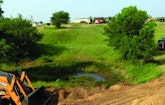
Interested in Septic Tanks?
Get Septic Tanks articles, news and videos right in your inbox! Sign up now.
Septic Tanks + Get AlertsIf life as we know it were to end because of a natural disaster or nuclear attack, survivors would still have to satisfy basic needs in order to keep surviving. Mark Shepard confronted that thought when Quality Septic & Sewer of Overland Park, Kansas, was hired to install a wastewater system for a survival condo complex.
What made the project more interesting was the site. The condos were constructed within the ultimate survivable shelter: a decommissioned missile silo that in the early to mid-1960s served as part of the United States’ nuclear deterrent during the hottest years of the Cold War. At that time, the silo near Salina, Kansas, held an Atlas F intercontinental ballistic missile.
After decommissioning, the silo languished for several years until it was purchased by a company that had developed a similar set of survival condominiums at another decommissioned silo several miles away.
Shepard’s task was to provide a wastewater system to serve condo residents for years without technical help, because if the world ends, residents will be inside with their five-year food supply but without the ability to call a wastewater professional.
The website for the project (survivalcondo.com) says the converted silo will support 36 to 70 people within its 14 stories. Condo units that occupy a full-floor area are designed for six to 10 people and have 1,820 square feet. Half-floor units have about 900 square feet of living space for three to five people. Prices range from $1.5 to $4.5 million.
Keep it simple
The condo complex occupies 5 acres, but while the surface area of the site is that large, the missile silo consumes much of the space underground, which produced a challenge in siting components. Another challenge was topography. Near the silo was a pair of dry retention ponds surrounded by berms with sides too steep for vehicles to climb. The ponds proved to be the best place for the drainfield.
Although called ponds, the depressions showed no ability to hold water, Shepard says. Even a heavy rain left only scattered puddles at grade. This section of the property had broken sandstone mixed with the area’s sandy soil. Obviously, the sandstone pieces came from excavation for the silo, and the soil was used to build the berms, Shepard says.
For maximum simplicity, Shepard and engineer Tom Hampton settled on a series of standard septic tanks feeding an Advanced Enviro-Septic drainfield system from Presby Environmental. The system is gravity-powered once wastewater arrives in the first tanks.
Prior to the first tanks, power is involved. The condo website advertises redundant power supplies and shows pictures of a wind turbine and a large generator. All wastewater will be collected at the bottom of the 175-foot-deep silo. Above it will be the condominium units, a small medical facility, an exercise space and an aquaculture installation. A pair of grinder pumps to be installed later by another contractor will send wastewater through a 2-inch force main made of heavy, rolled plastic.
Shepard did not do the interior work, only the treatment system. The owners wanted that in place before interior construction began, so Shepard connected only one outside bathroom for use by the construction crew. The owners will connect the grinder pumps to the wastewater system later.
Redundant tanks
The force mains are adapted to 4-inch Schedule 40 PVC that runs into the ends of 2,000-gallon concrete septic tanks. There are six of these in all, set in two lines of three and connected in series at the top. All the tanks came from Trigard Concrete Products in Belleville, Kansas, and have risers and lids from Polylok. The tanks provide both settling and primary treatment.
From the tanks, more Schedule 40 PVC leads effluent out toward the drainfield. But before it gets there, it passes through a pair of ball valves about 10 feet from the end of each tank.
This was a change Shepard made in the field while he was thinking about the need for the system to be independent of technical help. The valves will allow for shutting off half of the drainfield and channeling all the effluent to the other half should some problem arise. This will have to be done outside at the valve and not remotely from inside the silo.
The drainfields are about 100 feet from the septic tanks, and a run of 4-inch SDR 35 pipe takes effluent from the ball valves to the distribution boxes. Four-inch laterals distribute effluent into the Presby pipes.
There are four beds in the drainfield. Under normal circumstances, two beds are dosed by one set of three tanks and one distribution box, and the other two beds by the other set of tanks and a separate distribution box. Each bed comprises of 10 lines, all 70 feet long, for a total of 2,800 total linear feet of Presby pipe. Each bed is further split into four cells, and if it becomes necessary to adjust the effluent flow to completely fill all the pipes, Shepard will install slotted flow-equalization caps over the ends of the laterals. It’s another non-mechanical, low-technology, survivable solution.
The drainfield beds sit on a 12-inch layer of sand. Lines are spaced 12 inches apart, and there is 6 inches of sand above the lines. A 10-foot-wide perimeter of sand surrounds each bed.
Tight digging
Construction was not difficult because of the sandy soil, Shepard says. Even the broken sandstone was easily handled. He took along his pair of Takeuchi TL230 compact track loaders to move earth around. His Case backhoe did the heavy digging.
The tanks were placed inside one of the berms and covered with excavated soil. This provided about 15 feet of fall for effluent from tanks to the drainfield, but it was also a necessity because of the space used by the missile silo.
When they began, Shepard and his crew used the excavated soil to build a ramp so the crane truck could approach the tank site. “Between the silo and our tank site there was a depression that restricted our movement. There was only one narrow path to the tank site, and every day we had to make sure our equipment was facing in the right direction so we could drive it out,” he says.
They cut in from the side of the berm because its top was only about 8 feet wide. After the tanks were in place they backfilled with the soil they had excavated. The landowners handled restoration.
To set the drainfield pipes Shepard made a wooden template to ensure proper spacing. He bought several sheets of plywood, cut arches in them, and placed them over the Presby pipes to hold them in place while his crew filled sand around them. Other parts of the work provided a different challenge that Shepard solved in a different way.
“I’ve never had such a large project, and we started running out of time to complete the job. I knew it was time to be creative,” Shepard says.
He went to a local gas station, approached some of the teenagers working there, and asked if they or their friends would be willing to work for him. There isn’t much for young people to do in this part of Kansas, and they were willing. He used teens to hook the Presby pipes together as they came out of the truck and to rake sand into place on top of the beds. Over the course of three days he employed six teenagers on the project.
If the end of the world ever comes, the people sheltered inside the survival condominiums in Kansas won’t have to worry about their wastewater. As long as the complex has power from its wind turbine or generator, the gravity system from Quality Septic & Sewer will treat wastewater long after the food is gone.








